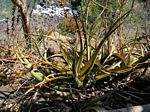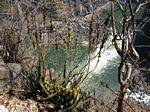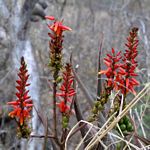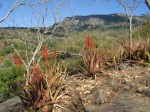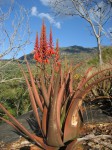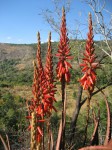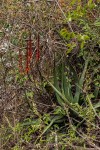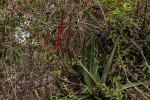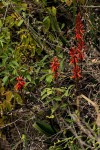Aloe cryptopoda
Selected images: Click on each image to see a larger version and details of the record View all images (10)
Photo: Helen Pickering
Zambian side of Victoria Falls: within the fenced Falls area, downstream from the falls on the edge of the cliff almost opposite the Zambian customs/immigration building
Photo: Helen Pickering
Zambian side of Victoria Falls: within the fenced Falls area, downstream from the falls on the edge of the cliff almost opposite the Zambian customs/immigration building
Detailed records: Display species records QDS maps by: Google Maps Point records by Google Maps
Species details: Click on each item to see an explanation of that item (Note: opens a new window)
| Synonyms: | |
| Common names: | Dr Kirk's aloe (English) |
| Frequency: | Locally frequent |
| Status: | Native |
| Description: |
Stemless succulent perennial herb, solitary or suckering to form small groups. Leaves in a dense rosette, often erect and curved inwards, 60-90 cm long, greyish-green, purple-tinged in dry conditions, without spots containing a yellow sap. Inflorescences 1-3, erect, 1-1-75 m high, up to 4-branched. Racemes densely many-flowered, 20-45 cm long. Flowers tubular, 28-35 mm long, bright orange-red, greenish to yellow-tipped. |
| Type location: |
|
| Notes: | |
| Derivation of specific name: | cryptopoda: with a "hidden foot", referring to the large bracts, obscuring the pedicels |
| Habitat: | On bare rocky slopes, often on steep edges, protected from fire. |
| Altitude range: (metres) | Up to 1525 m |
| Flowering time: | May - Jul |
| Worldwide distribution: | Malawi, Mozambique, Zambia, Zimbabwe and possibly southern Tanzania |
| FZ divisions: | N,W,C,E,S |
| Growth form(s): | |
| Endemic status: | |
| Red data list status: | |
| Insects associated with this species: | |
| Spot characters: | Display spot characters for this species |
| Images last updated: | Tuesday 9 February 2010 |
| Literature: |
Carter, S. (2001). Aloaceae Flora Zambesiaca 12(3) Pages 94 - 96. (Includes a picture). Da Silva, M.C., Izidine, S. & Amude, A.B. (2004). A preliminary checklist of the vascular plants of Mozambique. Southern African Botanical Diversity Network Report No. 30 Sabonet, Pretoria Page 120. Lane, S.S. (2004). A Field Guide to the Aloes of Malawi Umdaus Press, Hatfield South Africa. Page 19. (Includes a picture). Linley, K. & Baker, B. (1972). Flowers of the Veld Bundu Series Longman Zimbabwe Page 14. Mapaura, A. & Timberlake, J. (eds) (2004). A checklist of Zimbabwean vascular plants Southern African Botanical Diversity Network Report No. 33 Sabonet, Pretoria and Harare Page 84. Pickering, H. & Roe, E. (2009). Wild Flowers of the Victoria Falls Area Helen Pickering, London Page 31. (Includes a picture). Setshogo, M.P. (2005). Preliminary checklist of the plants of Botswana. Sabonet Report no. 37. Sabonet, Pretoria and Gaborone Page 115. West, O. (1974). A Field Guide to the Aloes of Rhodesia. Longman, Salisbury Pages 72 - 74. (Includes a picture). Wursten, B., Timberlake, J. & Darbyshire, I. (2017). The Chimanimani Mountains: an updated checklist. Kirkia 19(1) Page 81. |
Other sources of information about Aloe cryptopoda:
Our websites:
Flora of Botswana: Aloe cryptopodaFlora of Malawi: Aloe cryptopoda
Flora of Mozambique: Aloe cryptopoda
Flora of Zambia: Aloe cryptopoda
Flora of Zambia: cultivated Aloe cryptopoda
External websites:
African Plants: A Photo Guide (Senckenberg): Aloe cryptopodaAfrican Plant Database: Aloe cryptopoda
BHL (Biodiversity Heritage Library): Aloe cryptopoda
EOL (Encyclopedia of Life): Aloe cryptopoda
GBIF (Global Biodiversity Information Facility): Aloe cryptopoda
Google: Web - Images - Scholar
iNaturalist: Aloe cryptopoda
IPNI (International Plant Names Index): Aloe cryptopoda
JSTOR Plant Science: Aloe cryptopoda
Mansfeld World Database of Agricultural and Horticultural Crops: Aloe cryptopoda
Plants of the World Online: Aloe cryptopoda
Tropicos: Aloe cryptopoda
Wikipedia: Aloe cryptopoda
